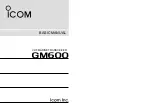
Page 15
RF65
Tel: +86-755-82973805 Fax: +86-755-82973550 E-mail: sales@hoperf.com http://www.hoperf.com
ADVANCED COMMUNICATIONS & SENSING
DATASHEET
3. Chip Description
This section describes in depth the architecture of the RF65 low-power, highly integrated receiver.
3.1. Power Supply Strategy
The RF65 employs an advanced power supply scheme, which provides stable operating characteristics over the full
temperature and voltage range of operation.
The RF65 can be powered from any low-noise voltage source via pins VBAT1 and VBAT2. Decoupling capacitors should be
connected, as suggested in the reference design on VR_DIG and VR_ANA pins to ensure a correct operation of the
built-in voltage regulators.
3.2. Low Battery Detector
A low battery detector is also included allowing the generation of an interrupt signal in response to passing a
programmable threshold adjustable through the register
RegLowBat
. The interrupt signal can be mapped to any of the DIO
pins, through the programmation of
RegDioMapping
.
3.3. Frequency Synthesis
The LO generation on the RF65 is based on a state-of-the-art fractional-N PLL. The PLL is fully integrated with
automatic calibration.
3.3.1. Reference Oscillator
The crystal oscillator is the main timing reference of the RF65. It is used as a reference for the frequency synthesizer and
as a clock for the digital processing.
The XO startup time, TS_OSC, depends on the actual XTAL being connected on pins XTA and XTB. When using the built-
in sequencer, the RF65 optimizes the startup time and automatically triggers the PLL when the XO signal is stable. To
manually control the startup time, the user should either wait for TS_OSC max, or monitor the signal CLKOUT which will
only be made available on the output buffer when a stable XO oscillation is achieved.
An external clock can be used to replace the crystal oscillator, for instance a tight tolerance TCXO. To do so, bit 4 at
address 0x59 should be set to 1, and the external clock has to be provided on XTA (pin 4). XTB (pin 5) should be left open.
The peak-peak amplitude of the input signal must never exceed 1.8 V. Please consult your TCXO supplier for an
appropriate value of decoupling capacitor, C
D
.
XTA
XTB
TCXO
32 MHz
NC
OP
Vcc
Vcc
GND
C
D
Figure 4. TCXO Connection
















































